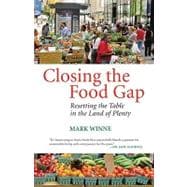
| Introduction: I've Come to...Shop? | p. xi |
| The History | |
| Suburbia, Environmentalism, and the Early Gurglings of the Food Movement | p. 3 |
| Reagan, Hunger, and the Rise of Food Banks | p. 21 |
| The Reactions | |
| Farmers' Markets: Bringing Food to the People | p. 37 |
| Community Gardens: Growing Our Own | p. 50 |
| Food Banks: Waste Not, Want Not | p. 69 |
| The Current Landscape | |
| Re-Storing America's Food Deserts | p. 85 |
| Growing Obese and Diabetic; Going Local and Organic | p. 110 |
| Community Supported Agriculture: Communities Find the Way | p. 137 |
| Public Policy: Food for the People | p. 149 |
| Income Disparities, Poverty, and the Food Gap | p. 173 |
| Conclusion: Resetting America's Table | p. 183 |
| A Note on Sources | p. 195 |
| Table of Contents provided by Ingram. All Rights Reserved. |
The New copy of this book will include any supplemental materials advertised. Please check the title of the book to determine if it should include any access cards, study guides, lab manuals, CDs, etc.
The Used, Rental and eBook copies of this book are not guaranteed to include any supplemental materials. Typically, only the book itself is included. This is true even if the title states it includes any access cards, study guides, lab manuals, CDs, etc.